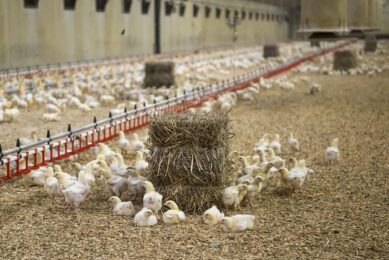Moving away from skip-day feeding in broiler breeders

Skip-day feeding is still used today in North America and is allowed in the EU. However, daily feeding to a higher weight provides not just welfare benefits but economic benefits as well.
To meet consumer demand and ensure profitability for broiler producers, the breeding of broilers globally over the years has resulted in birds that grow quickly and are very lean. The broiler breeder hens that produce broiler chicks also have these same characteristics that must be carefully managed. In short, this means that they must be fed so that they do not grow too quickly or store too much fat.
While some fat deposition is certainly necessary for egg production, too much fat deposited around the ovaries lowers the number of eggs produced per broiler breeder hen.
The feeding strategy used in North America and other parts of the world to control growth rate and excessive fat deposition, resulting in birds that reach a set weight and produce a given number of eggs, is skip-day feeding, i.e. feeding every 48 hours.
Not best for welfare or profits
Skip-day feeding comes with welfare concerns (and indeed, skip-day feeding is banned in some European countries). Furthermore, according to Dr Martin Zuidhof, professor of Poultry Systems Modeling and Precision Feeding at the University of Alberta in Canada, it is also not the best production strategy to use today from a profit standpoint.
“We here in North America should be moving away from skip-day feeding because it’s severe, but also because it’s not the best way to operate a broiler breeder farm with today’s genetics,” explains Zuidhof. “Our research shows that it’s more beneficial, economically, to raise broiler breeder hens to a higher weight – and yes, you can achieve this by feeding a bigger meal every 48 hours, but that’s a long time between meals – and you can also get there by feeding every day. And you get a different metabolic effect that provides outstanding performance.”
“When you feed every day, all the feed goes into running the body and producing eggs…”
Skip-day feeding, he says, results in some of the feed going into fat storage, but he and his colleagues have found that “when you feed every day, all the feed goes into running the body and producing eggs. So you get increased egg production. But we found that you get better performance of the broiler chicks as well.”
Genetic potential – room for improvement
Building on a 2018 study, ‘Lifetime productivity of conventionally and precision-fed broiler breeders’, Zuidhof discovered that hens fed to a heavier weight produce broiler offspring that at 42 days have a 5% increase in body weight compared to conventionally-raised broilers. The genetic potential for 145 chicks/broiler breeder hens also shows there is room for improvement over the current rate of 115 (average in Alberta). He plans to more fully examine the impact of maternal body weight on reproductive efficiency and offspring performance, and notes that Aviagen is interested in this research.
Less aggression among hens
In addition, his PhD student, Mohammad Afrouziyeh, has shown that feeding every day provides economic returns through reduced aggression. With skip-day feeding, birds are more aggressive perhaps because they are hungry more of the time or experience stress because they are uncertain when their next meal will be.
”…high rates of feather pecking, more mortality and lower overall flock performance compared to flocks fed every day.”
Farmers, therefore, see high rates of feather pecking, more mortality and lower overall flock performance compared to flocks fed every day. Of course, the economic benefits of better flock performance, more chicks per broiler breeder hen and better offspring performance are fully realised at integrated operations. However, if an operation is strictly broiler-breeder it will still reap economic benefits from better flock performance and more chicks per hen and thus be able to offer their broiler producer customers better chicks.
Zuidhof also notes that from a product marketing perspective, chicken from broilers farmed in such a system could be certified welfare-friendly and fetch a premium price and simply outcompete conventional chicken because customers prefer it.
A feeding system for broiler breeder hens
To research broiler breeder hen feeding strategies, Zuidhof has created a precision feeding system. Each broiler breeder hen has an RFID chip and can enter the feeder many times a day but is only provided feed according to how far her weight deviates from the daily pre-programmed target weight. And although such a system is not yet economically viable commercially, there is every reason to believe it may become so.
Broiler breeders prefer wooden nests
Number of eggs, fertility and hatchability – as a broiler breeder operation there are many parameters to keep on top of. One extra headache is the number of floor eggs as they involve extra labour. Read more…
“I’m working with an engineer to make my system more economical,” says Zuidhof, “but we need to understand that precision feeding also provides benefits for male fertility. On broiler breeder farms there is wide variation in the males, more than with hens, but precision feeding results in very strong male uniformity with a high fertility rate. Infertile eggs are a huge economic problem, with males typically having to be replaced at a rate of about 40% in a process called spiking. So increasing male fertility is another huge economic benefit of precision feeding that will make the return on investment timeline all the more attractive.”
Automatic weighing of birds
He further points to the possibility of a simplified precision feeding system where there is a scale that birds must stand on to feed and, while they are not identified individually, they are all automatically weighed throughout the day as they approach the feeder, their weights compared against a target weight and meal volumes provided accordingly.
Other factors that influence chick production
However, Zuidhof notes that precision feeding is only one factor that influences chick production. Photoperiod and other factors also need to be carefully managed. And because there is insufficient collective knowledge on broiler breeder hen nutrition, he also wants to study nutrient requirements and how feed timing and the use of different formulations can affect performance.
It has been found, for example, that a calcium-rich feed in the afternoon is best for layers because the calcium is then much more readily available for egg formation. This is something that needs to be further investigated in broiler breeder hens.
More transparency and ‘real change’
Looking forward, Zuidhof says, “I think it will be hard to convince the industry to move away from skip-day, but as the consumer landscape continues to evolve, the longer we use it, the worse it looks.”
More transparency is needed, in his view, along with real change. “We need to show that, yes, we have skip-day, but we’re discovering there are ways to manage feeding that are better for the birds. The good news is that these ways are better for producers’ bottom line as well.”
Join 31,000+ subscribers
Subscribe to our newsletter to stay updated about all the need-to-know content in the poultry sector, three times a week. Beheer
Beheer








 WP Admin
WP Admin  Bewerk bericht
Bewerk bericht